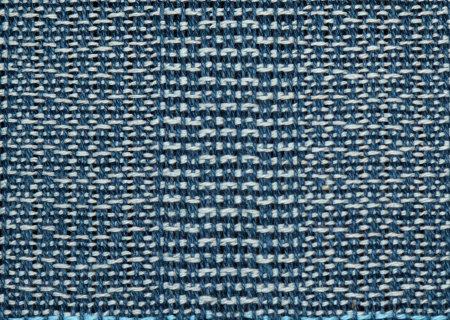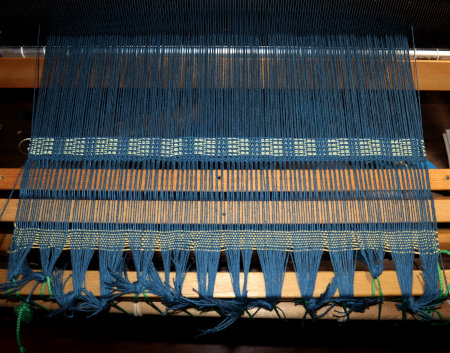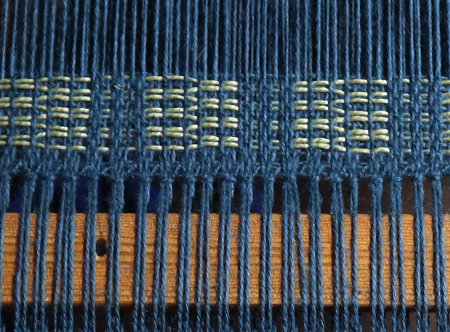Last time, I shared that my next project is going to be a second table runner, this one in crackle. I already had a pattern weft picked out and in looking at warp and background weft possibilities, I was thinking 10/2 in navy blue. But alas, my only cone of navy in that size is pretty scant, so I started hunting around online for more.
In doing that, I made a discovery which is likely won't surprise most folks but is potentially helpful for me. And that is that 10/2 cotton and #10 crochet cotton are the same size. I came across this tidbit during an internet hunt for 10/2 cotton, as I have very little of the color I want. One mega site was listing 10/2 as size 10 crochet thread. Well, I'd never heard that before and so checked the size of both on my measuring stick.
Both counted out as 34 wraps per inch.
Two questions immediately popped into my mind: which is easier to find and what's the difference in price? Crochet cottons are sold at local hobby supply shops and big box department stores like WalMart. Weaving yarns are sold at weaving supply shops, and I'm fortunate to have one in the area. I prefer to buy locally and prefer the smaller businesses, if possible. After that, it's ordering online.
One thing I discovered, is that my area weaving store doesn't carry 10/2 in navy blue. The closest is something similar to royal blue, sold in 200 gram cones with 1854 yards per cone. $20 per cone.
Of crochet cotton, WalMart doesn't carry navy blue in size 10. In fact, they don't carry any blue in size 10. It seems like black, white, neutral, and red are the only offerings. So I visited Hobby Lobby. While I didn't find navy blue, I found the lovely blue you see on the left in the photo above. $4 for 400 yards. A yardage equivalent to the cone of 10/2 would price it at $18.54 for the same amount.
Online, it looks like 10/2 ranges from $33 to $42 per pound (4200 yards), and I found the 200 gram cone I can buy in town, but for $26. None of that includes shipping, so that's an additional cost. Crochet cotton purchased online typically runs somewhere around $6.50 for 350 yards, plus shipping.
For sampling, I bought one of the #10s from Hobby Lobby. How's it weaving?
 |
"Scandinavian Favorite" treadling #1 from A Handweaver's Pattern Book,
Warp and tabby weft are size 10 crochet cotton, pattern weft is 5/2 cotton. |
Pretty good! And I have to say the royal blue background with the green pattern is growing on me. But I'm also going to do some sampling with my 8/2 navy, just to compare.
Related Post



































